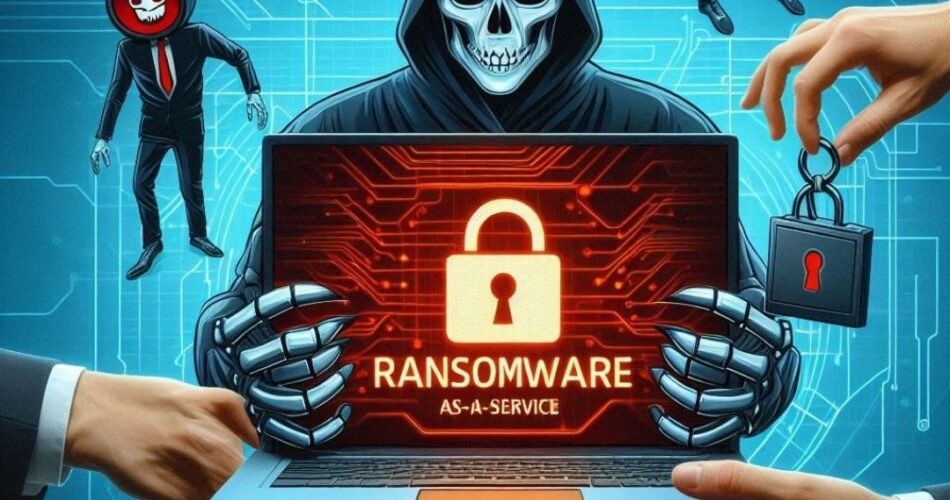Introduction
The rise of Ransomware has been one of the most significant cybersecurity threats in recent years, but a new development has made this menace even more accessible and dangerous: Ransomware-as-a-Service (RaaS). Just like legitimate businesses offering software as a service, cybercriminals are now offering ransomware tools and infrastructure to other attackers, allowing anyone with malicious intent to launch devastating ransomware attacks.
In this blog, we’ll explain how RaaS works, why it’s so dangerous, and what you can do to protect yourself.
What is Ransomware-as-a-Service (RaaS)?
Ransomware-as-a-Service (RaaS) is a business model used by cybercriminals to sell or rent out ransomware tools and services. It allows even non-technical individuals to launch ransomware attacks by providing a platform that handles the development, distribution, and management of ransomware.
How RaaS Works
- The RaaS Provider
- Skilled cybercriminals develop sophisticated ransomware strains and create an online service platform.
- They advertise their platform on dark web forums, offering anyone the ability to sign up and use the service.
- The Affiliate
- The “affiliate” (another cybercriminal or even an individual with no coding knowledge) joins the RaaS platform.
- The affiliate uses the platform to customize and launch ransomware campaigns against chosen targets.
- The RaaS platform often provides tutorials, tools, and customer support to help affiliates succeed.
- Ransomware Distribution
- The affiliate distributes the ransomware via phishing emails, malicious links, or exploiting vulnerabilities in networks.
- Once the ransomware encrypts the victim’s data, the affiliate demands a ransom in exchange for the decryption key.
- Profit Sharing
- The affiliate receives a portion of the ransom payment, while the RaaS provider takes a cut (often between 20-40%).
- This incentivizes both parties to keep the attacks going, leading to more frequent and widespread ransomware campaigns.
Why RaaS is So Dangerous
1. Accessibility
RaaS lowers the barrier to entry for cybercriminals. Anyone, even without technical expertise, can launch ransomware attacks simply by subscribing to a RaaS platform. This has led to an explosion in the number of ransomware attacks, targeting businesses and individuals alike.
2. Increased Attack Frequency
With more affiliates using RaaS platforms, the volume of ransomware attacks has increased dramatically. Small and medium-sized businesses, in particular, are often the victims because they typically have weaker security defenses compared to large enterprises.
3. Advanced Ransomware
RaaS platforms provide highly sophisticated ransomware strains that are capable of evading traditional security measures. These ransomware variants often feature advanced encryption algorithms, making it nearly impossible for victims to recover their data without paying the ransom.
4. Support Networks for Criminals
RaaS providers offer more than just software; they often provide customer support, how-to guides, and even real-time chat assistance to their affiliates. This “service model” makes it easier for affiliates to conduct successful attacks, even if they are new to the world of cybercrime.
Real-World Examples
1. DarkSide RaaS
In 2021, the DarkSide ransomware group launched a major attack on the Colonial Pipeline, causing fuel shortages across the eastern United States. DarkSide operated as a RaaS platform, where affiliates used their ransomware to target victims, while DarkSide took a share of the profits.
2. REvil RaaS
REvil, another notorious ransomware group, targeted companies worldwide, encrypting their data and demanding massive ransoms. They also operated as a RaaS, offering their ransomware tools to affiliates, who then launched attacks on various industries, including healthcare and IT services.
How to Protect Against RaaS Attacks
1. Regular Backups
- Regularly back up your critical data and store it in a secure location, disconnected from your network. This ensures you can recover your data in case of a ransomware attack without paying the ransom.
2. Keep Systems Updated
- Ensure that all software, operating systems, and security tools are updated regularly. Ransomware often exploits known vulnerabilities in outdated systems.
3. Use Multi-Factor Authentication (MFA)
- Enable MFA on all accounts and network systems. MFA can prevent attackers from gaining unauthorized access, even if they manage to steal login credentials.
4. Employee Training
- Educate employees about the risks of phishing and the importance of being cautious with email attachments, links, and suspicious messages. Many ransomware attacks begin with a simple phishing email.
5. Implement Advanced Security Tools
- Use advanced security measures like endpoint protection, firewall rules, and network segmentation to limit the spread of ransomware in case of an infection.
The Future of RaaS
Ransomware-as-a-Service is likely to become more prevalent as the profitability of ransomware continues to attract cybercriminals. As RaaS platforms become more advanced, we can expect even more frequent and sophisticated attacks. However, as awareness of RaaS grows, organizations and individuals can take proactive steps to strengthen their cybersecurity defenses and reduce the risk of falling victim to these attacks.
Conclusion
Ransomware-as-a-Service represents a dangerous shift in the cybercriminal landscape, making powerful ransomware tools available to a broader audience. With the rise of RaaS, ransomware attacks are more common and more devastating than ever. By understanding the threat and implementing proper security measures, businesses and individuals can protect themselves from becoming victims of this new breed of cyberattack.
Stay updated with BugBountyTip.Tech for the latest news and tips on how to safeguard against the ever-evolving cyber threats.

